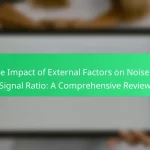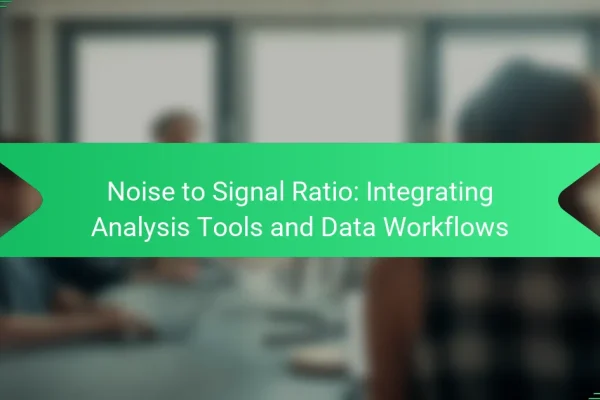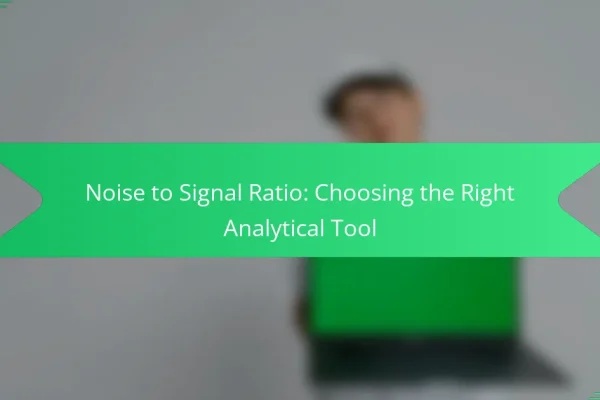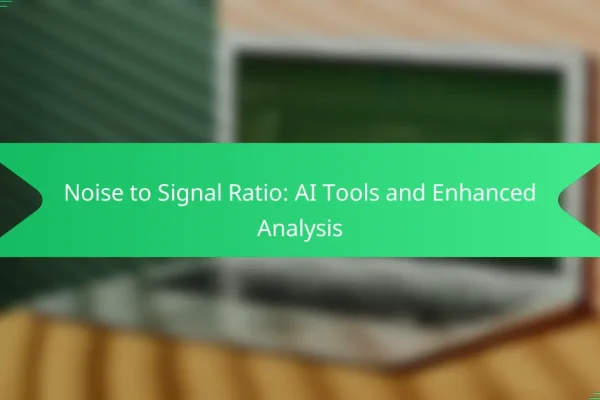What tools analyze Noise to Signal Ratio?
Several tools can effectively analyze Noise to Signal Ratio (NSR), each offering unique features and capabilities. Common options include audio editing software, programming languages, and specialized engineering applications.
Audacity
Audacity is a free, open-source audio editing tool that allows users to analyze and manipulate sound files. It includes features for measuring NSR by visualizing waveforms and spectrograms, making it easier to identify noise levels relative to the signal.
To analyze NSR in Audacity, import your audio file, select a portion of the signal, and use the “Analyze” menu to access tools like “Plot Spectrum.” This helps in determining the frequency components of both noise and signal.
MATLAB
MATLAB is a powerful programming environment widely used for numerical computing and data analysis. It offers built-in functions to compute NSR, making it suitable for engineers and researchers who require precise calculations.
To analyze NSR in MATLAB, you can use functions like ‘pwelch’ for power spectral density estimation. This allows you to compare the power of the signal against the noise, providing a clear NSR value.
Python Libraries
Python offers several libraries, such as NumPy and SciPy, that can be utilized for NSR analysis. These libraries provide tools for signal processing, allowing users to calculate NSR through various algorithms.
For instance, using the ‘scipy.signal’ module, you can apply filters to isolate noise and signal components, then compute their respective powers to derive the NSR. This approach is flexible and can be adapted for different types of data.
R Programming
R is a statistical programming language that includes packages for signal processing, such as ‘signal’ and ‘seewave.’ These packages can be used to analyze NSR in various datasets, particularly in research contexts.
In R, you can use functions to perform Fourier transforms and calculate the power spectrum, which helps in determining the NSR. This is particularly useful in fields like bioacoustics or environmental monitoring.
LabVIEW
LabVIEW is a system-design platform used for data acquisition and instrument control, often in engineering applications. It provides tools for real-time signal analysis, including NSR measurement.
To analyze NSR in LabVIEW, you can utilize its built-in signal processing functions to filter and analyze data streams. This is particularly beneficial for applications requiring immediate feedback and control, such as in industrial settings.
How to choose the right tool for Noise to Signal Ratio analysis?
Selecting the appropriate tool for Noise to Signal Ratio (NSR) analysis depends on the specific requirements of your data and the context of your analysis. Key factors include the type of data you are working with, the ease of use of the tool, and how well it integrates with other systems you may be using.
Consider the data type
The type of data you are analyzing significantly influences your choice of NSR analysis tools. For instance, if you are working with audio signals, tools that specialize in sound analysis will be more effective. Conversely, for financial data, consider software that can handle time series analysis and statistical modeling.
Additionally, consider whether your data is structured or unstructured. Structured data may work well with traditional statistical tools, while unstructured data may require more advanced analytics or machine learning capabilities.
Evaluate user-friendliness
User-friendliness is crucial when selecting an NSR analysis tool, especially if team members have varying levels of technical expertise. Look for tools with intuitive interfaces, clear documentation, and accessible customer support. A user-friendly tool can reduce the learning curve and enhance productivity.
Consider trial versions or demos to assess how easy the tool is to navigate. Tools that offer visual representations of data can also help users understand results more quickly, making the analysis process smoother.
Assess integration capabilities
Integration capabilities are essential for ensuring that your NSR analysis tool works seamlessly with other software and data sources. Check if the tool can connect with databases, data visualization platforms, or other analytics tools you are currently using.
Tools that support common data formats and APIs will provide greater flexibility and efficiency. This can save time and reduce errors when transferring data between systems, ultimately leading to more accurate NSR analysis.
What are the benefits of analyzing Noise to Signal Ratio?
Analyzing the Noise to Signal Ratio (NSR) provides significant advantages, including improved data quality, enhanced decision-making, and increased operational efficiency. By understanding the NSR, organizations can filter out irrelevant information and focus on valuable insights.
Improved data quality
Analyzing NSR helps identify and minimize noise in data sets, leading to higher quality information. This process involves assessing the reliability of data sources and implementing filtering techniques to eliminate inaccuracies. For instance, businesses can use statistical methods to determine which data points contribute to noise and adjust their data collection practices accordingly.
Regularly reviewing data quality metrics can help organizations maintain clean datasets, ensuring that decisions are based on accurate and relevant information.
Enhanced decision-making
A clear understanding of NSR allows decision-makers to rely on more accurate data, leading to better strategic choices. By focusing on high-signal data, organizations can identify trends and patterns that would otherwise be obscured by noise. This clarity can be particularly beneficial in sectors like finance or healthcare, where data-driven decisions are critical.
To enhance decision-making, teams should establish protocols for regularly evaluating the NSR of their data sources and adjust their strategies based on the insights gained.
Increased operational efficiency
Improving NSR can lead to increased operational efficiency by streamlining processes and reducing wasted resources. When organizations can quickly identify valuable data, they can allocate time and effort more effectively, minimizing distractions from irrelevant information. For example, a marketing team that focuses on high-signal customer feedback can tailor campaigns more efficiently.
To maximize operational efficiency, organizations should implement tools that continuously monitor and analyze NSR, ensuring that they adapt to changing data environments and maintain a focus on quality insights.
What are common challenges in Noise to Signal Ratio analysis?
Noise to Signal Ratio (NSR) analysis often faces challenges such as data variability, tool complexity, and interpreting results. These factors can significantly impact the accuracy and reliability of the analysis, making it essential to understand and address them effectively.
Data variability
Data variability refers to the fluctuations in data that can obscure the true signal. In NSR analysis, high variability can lead to misleading conclusions, as it may mask the actual relationship between noise and signal. It’s crucial to collect data from consistent sources and apply techniques to minimize variability, such as standardizing measurement conditions.
For example, when analyzing audio signals, environmental factors like background noise can introduce variability. Using controlled settings can help ensure that the data reflects the true NSR without external interference.
Tool complexity
The complexity of tools used for NSR analysis can be a barrier, especially for those unfamiliar with advanced statistical methods. Many software packages offer a range of features, but understanding how to utilize them effectively requires training and experience. It’s advisable to start with user-friendly tools that provide clear documentation and support.
Consider using open-source software like R or Python libraries, which offer flexibility and a wealth of resources for beginners. These tools can help simplify the analysis process while still delivering robust results.
Interpreting results
Interpreting the results of NSR analysis can be challenging due to the potential for misinterpretation. A high NSR may indicate a strong signal, but it can also be influenced by external factors that need consideration. Understanding the context of the data is essential for accurate interpretation.
To avoid common pitfalls, always cross-reference NSR findings with other metrics and domain-specific knowledge. For instance, in telecommunications, a high NSR might suggest good signal quality, but it should be validated against user experience and performance metrics to ensure comprehensive understanding.
What are best practices for Noise to Signal Ratio analysis?
Best practices for analyzing Noise to Signal Ratio (NSR) involve establishing clear objectives and utilizing multiple tools for validation. These strategies help ensure accurate and reliable results, which are crucial for effective decision-making.
Define clear objectives
Defining clear objectives is essential for effective NSR analysis. Start by identifying what you aim to achieve with the analysis, whether it’s improving data quality, enhancing system performance, or optimizing resource allocation. This focus will guide your methodology and help you determine relevant metrics.
Consider setting specific, measurable goals. For example, you might aim to reduce noise levels by a certain percentage or improve the signal clarity within a defined timeframe. Clear objectives will streamline your analysis and facilitate better communication with stakeholders.
Use multiple tools for validation
Using multiple tools for validation enhances the reliability of your NSR analysis. Different tools can provide varied perspectives and help cross-verify results, reducing the likelihood of errors. Consider employing statistical software, data visualization tools, and domain-specific applications to gather comprehensive insights.
For instance, combining software that analyzes frequency response with tools that assess temporal resolution can give a more holistic view of the noise and signal characteristics. This multi-faceted approach not only strengthens your findings but also builds confidence in your conclusions.












